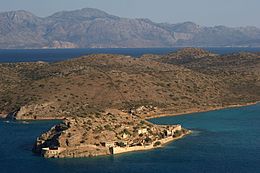Spinalonga
| Native name: Σπιναλόγκα (Καλυδών) | |
|---|---|

Panoramic view from the mountain
|
|
| Geography | |
| Coordinates | 35°17′51″N 25°44′17″E / 35.29750°N 25.73806°ECoordinates: 35°17′51″N 25°44′17″E / 35.29750°N 25.73806°E |
| Archipelago | Cretan Islands |
| Area | 0.085 km2 (0.033 sq mi) |
| Administration | |
|
Greece
|
|
| Region | Crete |
| Regional unit | Lasithi |
| Demographics | |
| Population | 0 (2001) |
The island of Spinalonga (Greek: Σπιναλόγκα), officially known as Kalydon (Καλυδών), is located in the Gulf of Elounda in north-eastern Crete, in Lasithi, next to the town of Plaka. The island is further assigned to the area of Kalydon. It is near the Spinalonga peninsula ("large Spinalonga") – which often causes confusion as the same name is used for both. The official Greek name of the island today is Kalydon.
Originally, Spinalonga was not an island – it was part of the island of Crete. During Venetian occupation the island was carved out of the coast for defence purposes and a fort was built there.
During Venetian rule, salt was harvested from salt pans around the island. The island has also been used as a leper colony. Spinalonga has appeared in novels, television series, and a short film.
According to Venetian documents, the name of the island originated in the Greek expression στην Ελούντα stin Elounda (meaning "to Elounda"). The Venetians could not understand the expression so they familiarized it using their own language, and called it spina "thorn" longa "long", an expression that was also maintained by the locals. The Venetians were inspired for this expression by the name of an island near Venice called by the same name and which is known today as the island of Giudecca.
The Venetian cartographer Vincenzo Coronelli reports that Spinalonga was not always an island, but was once linked with the adjacent Peninsula Spinalonga. He mentions that in 1526, the Venetians cut down a portion of the peninsula and thus created the island. Because of its position the island was fortified from its earliest years in order to protect the entranceway of the port of Ancient Olous.
Olous, and accordingly the wider region, were depopulated at the middle of the 7th century because of the raids of the Arab pirates in the Mediterranean. Olous remained deserted until the mid-15th century when the Venetians began to construct salt-pans in the shallow and salty waters of the gulf. Subsequently, the region acquired commercial value and became inhabited. This, in combination with the emergent Turkish threat, particularly after the Fall of Constantinople in 1453, and the continuous pirate raids, forced the Venetians to fortify the island.
...
Wikipedia

